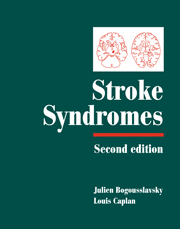Book contents
- Frontmatter
- Contents
- List of contributors
- Preface
- PART I CLINICAL MANIFESTATIONS
- PART II VASCULAR TOPOGRAPHIC SYNDROMES
- 29 Arterial territories of human brain
- 30 Superficial middle cerebral artery syndromes
- 31 Lenticulostriate arteries
- 32 Anterior cerebral artery
- 33 Anterior choroidal artery territory infarcts
- 34 Thalamic infarcts and hemorrhages
- 35 Caudate infarcts and hemorrhages
- 36 Posterior cerebral artery
- 37 Large and panhemispheric infarcts
- 38 Multiple, multilevel and bihemispheric infarcts
- 39 Midbrain infarcts
- 40 Pontine infarcts and hemorrhages
- 41 Medullary infarcts and hemorrhages
- 42 Cerebellar stroke syndromes
- 43 Extended infarcts in the posterior circulation (brainstem/cerebellum)
- 44 Border zone infarcts
- 45 Classical lacunar syndromes
- 46 Putaminal hemorrhages
- 47 Lobar hemorrhages
- 48 Intraventricular hemorrhages
- 49 Subarachnoid hemorrhage syndromes
- 50 Brain venous thrombosis syndromes
- 51 Carotid occlusion syndromes
- 52 Cervical artery dissection syndromes
- 53 Syndromes related to large artery thromboembolism within the vertebrobasilar system
- 54 Spinal stroke syndromes
- Index
- Plate section
41 - Medullary infarcts and hemorrhages
from PART II - VASCULAR TOPOGRAPHIC SYNDROMES
Published online by Cambridge University Press: 17 May 2010
- Frontmatter
- Contents
- List of contributors
- Preface
- PART I CLINICAL MANIFESTATIONS
- PART II VASCULAR TOPOGRAPHIC SYNDROMES
- 29 Arterial territories of human brain
- 30 Superficial middle cerebral artery syndromes
- 31 Lenticulostriate arteries
- 32 Anterior cerebral artery
- 33 Anterior choroidal artery territory infarcts
- 34 Thalamic infarcts and hemorrhages
- 35 Caudate infarcts and hemorrhages
- 36 Posterior cerebral artery
- 37 Large and panhemispheric infarcts
- 38 Multiple, multilevel and bihemispheric infarcts
- 39 Midbrain infarcts
- 40 Pontine infarcts and hemorrhages
- 41 Medullary infarcts and hemorrhages
- 42 Cerebellar stroke syndromes
- 43 Extended infarcts in the posterior circulation (brainstem/cerebellum)
- 44 Border zone infarcts
- 45 Classical lacunar syndromes
- 46 Putaminal hemorrhages
- 47 Lobar hemorrhages
- 48 Intraventricular hemorrhages
- 49 Subarachnoid hemorrhage syndromes
- 50 Brain venous thrombosis syndromes
- 51 Carotid occlusion syndromes
- 52 Cervical artery dissection syndromes
- 53 Syndromes related to large artery thromboembolism within the vertebrobasilar system
- 54 Spinal stroke syndromes
- Index
- Plate section
Summary
Lateral medullary infarction (LMI) is one of the best-recognized vascular syndromes of the vertebrobasilar territory, comprising about 2% of all admissions for acute stroke (Norrving & Cronqvist, 1991). Medial medullary infarcts (MMI) were previously thought to be very rare, but because they are difficult to diagnose without brain MRI their frequency has likely been underestimated before this technique became available (Kim et al., 1995; Toyoda et al, 1996; Bassetti et al., 1997). Combined medial and lateral infarcts, as well as medullary hemorrhages, are rare types of stroke, reported only as single cases or small patient series (Kase, 1994; Caplan, 1996).
Arterial supply of the medulla
The main arterial supply to the lateral medullary area is through a number of direct penetrating arteries that originate from the distal vertebral artery (Fig. 41.1). The area is also variably supplied by small branches arising from the the posterior inferior cerebellar artery (PICA), the anterior inferior cerebellar artery (AICA) or the basilar artery (Fisher et al., 1961). A lateral medullary infarct can be caused by occlusion of one or more of these penetrating arteries, most often secondary to occlusion of the vertebral artery. In cases with involvement of the PICA or AICA, a cerebellar infarction in the territory of these arteries may be coexisting, if not spared by means of collateral flow. The dorsal medulla is supplied only by branches from the PICA; a lesion in this area is nearly always accompanied by cerebellar infarction (Escourolle et al., 1976; Hauw et al., 1976).
- Type
- Chapter
- Information
- Stroke Syndromes , pp. 534 - 539Publisher: Cambridge University PressPrint publication year: 2001
- 7
- Cited by



